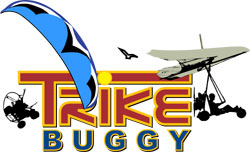

Powered Parachute
|
TrikeBuggy
|
What is it? |
|
| A Powered Parachute (PPC) is a flexible winged, Light Sport Aircraft. A PPC combines a three or four wheeled cart structure, holding pilot and motor with a large wing similar to those used by parachutists. The wing itself is made of Nylon fabric with suspension lines usually made of Spectra or Kevlar. The thrust from the engine pushes the cart forward and forces air into the leading edge of the wing, causing it to "inflate" and pressurize, thereby keeping the shape designed to fly as an airfoil. Most PPC's use rectangular chutes, but there are new elliptical technology chutes that are changing the way these fly. | A Powered Paraglider (PPG) Trike is also a flexible winged, ultralight vehicle (see description below) used for recreational purposes. A PPG Trike combines a three or four wheeled cart structure that holds pilot and motor with a paraglider. While similar to a PPC wing, the Paraglider wing is a higher performance airfoil which can be used for foot launched free flight, and is capable of soaring flight in thermals or ridge lift. Like a PPC, the PPG Trike inflates the wing by moving forward with the thrust from the motor. The airfoil shape of the paraglider is maintained in by the forward movement of the Trike through the air. |
How do I control it? |
|
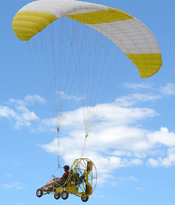 A PPC is usually steered on the ground by a hand controlled lever or steering wheel attached to the front wheel. The parachute is controlled by steering levers operated by the pilot's feet, and have a limited range of motion designed to keep the wing within safe flying speeds. Throttle is usually on the front wheel steering lever, but can also be next to the seat or mounted somewhere else on the airframe. A PPC is usually steered on the ground by a hand controlled lever or steering wheel attached to the front wheel. The parachute is controlled by steering levers operated by the pilot's feet, and have a limited range of motion designed to keep the wing within safe flying speeds. Throttle is usually on the front wheel steering lever, but can also be next to the seat or mounted somewhere else on the airframe. |
PPG Trikes are often steered on the ground using the pilot's feet, controlling the front wheel. The paraglider is controlled by the use of toggles in the pilot's hands, although many PPG Trikes, including the TrikeBuggy, can be fitted with a foot steering system that leaves the pilot's hands free for photos, videos, etc. A steering bar can also be added to most PPG Trikes, allowing one hand operation. Because the range of brake travel is so much greater on a paraglider, care must be exercised not to overcontrol or stall the aircraft. Power is typically operated by a hand throttle, although some PPG Trikes use foot throttles. PPG Trikes require pilot contact with the brake toggles on takeoff and landing, and in rougher air. In smooth conditions, the trimmers on the risers of the paraglider can be used to produce gentle turns on long cross country flights, freeing up the pilot's hands. |
How big is it? |
|
A PPC is quite large and heavy, certainly more than what is needed for one person to fly solo. The motor is often a Rotax or similar, with 400cc (around 40 hp.) or more of power, up to over 900cc (80-100 hp.). The motor alone often weighs several hundred pounds. They are around six feet wide and ten feet long. Canopies are from 400 to over 500 square feet in area, depending on payload (solo or tandem). 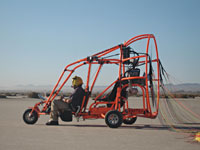 There is new demand for 103 legal machines now, and there are many new models that are smaller and lighter. Some are even using 4-stroke engines, making the fuel consumption and noise level better than before. There is new demand for 103 legal machines now, and there are many new models that are smaller and lighter. Some are even using 4-stroke engines, making the fuel consumption and noise level better than before. |
PPG Trikes are small and light, usually under 150 lbs. The motor is often fitted to the weight of the person flying the unit, and can be as little as 100cc in size, around 18 hp. More often, they are between 170cc and 325cc in size, somewhere between 20 and 35 hp. Most PPG motors are 2-stroke for increased power-to-weight ratio, but Bailey makes a great 4-stroke paramotor, and there is a new push to develop electric papamotors. The motor can also be removed from the trike and foot launched by the pilot, giving it extra versatility. The size of the trike can vary from less than four feet wide and five feet long to six feet wide and around the same length. Paraglider canopies range from under 200 square feet for solo flight to just under 400 for tandem use. |
Can I take my friends? |
|
Being able to take friends and family members along for flying is what still attracts people to powered parachuting. It also explains to some degree the heavier machines since larger payloads require larger engines, which then need heavier airframes. A machine that has the capability of taking along a friend or family member is a powered parachute (by FAA definition) and a light sport aircraft, and requires a Sport Pilot License to operate legally. |
PPG Trikes are Ultralight Vehicles, and are made for a single occupant only, they are used or intended to be used for manned operation in the air by a single occupant for recreation or sport purposes only. This is the essence of these small trikes, to provide the flying experience to the pilot, and not so much to give rides. |
How do I transport it? |
|
| Most PPC's weigh many hundreds of pounds, making it necessary to trailer or truck the unit to the runway. Moving the aircraft around is relatively easy, since there are three wheels to roll it easily along the ground. Ramps are needed to get the vehicle onto a trailer, and often another person is needed as well to push it up onto a trailer. There are some PPC's that attach to a car's trailer hitch, allowing you to tow the aircraft. | 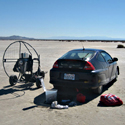 Most PPG Trikes are easily dismantled and folded for transport. The PPG motor often fits into a large suitcase or equivelent, and the trike is often folded or disassembled to fit into most car's trunks. Paraglider wings fit into a mid size backpack. Most PPG Trikes are easily dismantled and folded for transport. The PPG motor often fits into a large suitcase or equivelent, and the trike is often folded or disassembled to fit into most car's trunks. Paraglider wings fit into a mid size backpack. |
How fast does it fly? |
|
| PPC's fly at a relatively constant rate of speed all the time, due to the fixed forward glide speed of the airfoil design. Full throttle, half throttle and engine off have little effect on the forward speed, only on whether the craft is ascending or descending. PPC's fly at speeds of somewhere between 26 and 35 mph. | PPG Trikes are similar - to climb, simply add throttle; level flight is about 2/3 throttle; idle or engine off to descend back to the ground. Airspeed of a PPG Trike is somewhat slower that that of a PPC, around 20 - 25 mph, but with trimmers, higher speeds can be attained. |
How much wind can I fly in? |
|
| It is not recommended to fly PPC's in wind conditions exceeding 12-15 mph. Since this aircraft is heavier, it can be flown in slightly higher winds than a PPG Trike. Most PPC and PPG Trike pilots prefer to fly in the morning, late afternoon and into the evening when the wind conditions are smooth and calm. | As a beginner, we do not recommend flying in winds of more than 5-8 mph. Once a pilot has more experience, they may choose to fly in higher wind conditions, although the inherent beauty of this type of aircraft is being able to launch and land in calm conditions with minimal effort. Windy conditions can cause either a PPC pr PPG Trike to "turtle" onto its back, or simply be unpleasant and unsafe, due to turbulence. |
Where can I fly? |
|
| PPC's need a bit of a runway to roll out into flight. While they often operate at the same fields that PPG Trikes do, many times they will need a larger space for launch and landing. Both PPC's and PPG Trikes must be flown with respect to landowners and legal airspace, always check your Sectional map! | 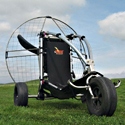 PPG Trikes are small enough to launch on a very short runway. Quite often, roads, beaches, fields and dry lakes are used to achieve flight. A PPG Trike is small and light enough to "wheelbarrow" through walkways to a launch site. PPG Trikes are small enough to launch on a very short runway. Quite often, roads, beaches, fields and dry lakes are used to achieve flight. A PPG Trike is small and light enough to "wheelbarrow" through walkways to a launch site. |
What happens if the engine quits? |
|
| No need to worry! In the unlikely event of an engine out, the pilot simply parachutes back to Mother Earth. Since a PPC is quite heavy, the landing can be quite hard, since there is limited ability to "flare" for a landing and the glide slope is quite steep. It is always recommended to keep a useable landing zone within glide at all times in both PPC's and PPG Trikes. | With a PPG Trike, if your motor ever quits, you glide back down to land just like a paraglider - with a good flare to round out the landing, setting the craft down gently. Because the PPG Trike uses a regular paraglider, the glide slope is significantly better than a PPC. Paragliders also fly slower than PPC's and use brake toggles in your hands, so executing a good flare to land softly is quite easy. |
How long can I fly on a tank of gas? |
|
| PPC's with 10 gallon fuel capacity can fly for up to 3 hours. Smaller PPC's with 5 gallons or less can fly for up to 2 hours. Due to the larger motor required to fly Powered Parachutes, the fuel consumption is considerably higher than a PPG Trike, around 3 gal/hr. A 4-stroke motor will usually consume much less fuel than a 2-stroke model, extending your flying time and range. | PPG Trikes vary widely in their manufacture. Some get only two hours of flight time before needing to be refueled, while others sip gas at a lower rate and/or have a larger tank that holds more fuel. Since the engine is so much smaller than a PPC, the fuel consumption is much less overall. Three to four hours of flight time is possible on many PPG motors, although your bladder may not be able to keep up! |
How much training do I need? |
|
| PPC dealers often state that you can learn to fly in 2-3 days. While this is true, this is quite often not enough supervised training to produce a safe pilot for the long term. There are many factors that are in play when we fly, we can't simply pull the plane over to the side of the road like we can our car! A Sport Pilot License will require more training and study to complete, and is required in order to operate most PPC's. | PPG Trikes use modern paragliders for their airfoil. Many factors must be considered and skills need to be mastered before we can be considered pilots. Our first solo flights are often made during the first weekend of training, but for certification we will need a minimum of five flying days under supervision. Remember, this is for your benefit! Competent, safe pilots fly for years - the rest of their lives, not just the rest of the week. |
Do I need a license? |
|
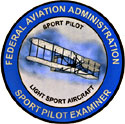 For most Powered Parachutes, you will need a Sport Pilot License, since most PPC's weigh more than 254 lbs and carry more than 5 gallons of fuel. PPC's will also need for you to register, N-number and obtain an Airworthiness Certificate for Special Light-Sport Aircraft. There are some 103 legal PPC's now available that are under 254 lbs and carry only 5 gallons of fuel, allowing them to operate under FAR Part 103 (see below). For most Powered Parachutes, you will need a Sport Pilot License, since most PPC's weigh more than 254 lbs and carry more than 5 gallons of fuel. PPC's will also need for you to register, N-number and obtain an Airworthiness Certificate for Special Light-Sport Aircraft. There are some 103 legal PPC's now available that are under 254 lbs and carry only 5 gallons of fuel, allowing them to operate under FAR Part 103 (see below). |
Powered Paraglider Trikes, like foot launched PPG's, are still considered Ultralight Vehicles, and do not require a license to fly. PPG Trikes also do not require registration with the FAA, N-numbers or Airworthiness Certificates. Most flying sites, however, require pilot certification to make sure there has been adequate training for the pilot to fly safely. Respect the pilot community and their desire to keep flying where they do - Get certified instruction! |
|
|---|
|
DISCLAIMER: Please read and be sure you thoroughly understand this disclaimer before flying a TrikeBuggy. Trike flying is an extremely demanding sport requiring exceptional levels of attention, judgment, maturity and self discipline. It is unlikely that you will be able to participate in it safely unless you make a conscious and continual commitment to your own safety. PPG and Hang Glider Trike flying is a dangerous sport and may result in injury and death even when practiced by a competent pilot using proper equipment. TrikeBuggies are not covered by product liability insurance, nor have they been designed, manufactured or tested to any federal or state government airworthiness standards or regulations. Do not fly them unless you are willing to assume personally all risks in the sport of Trike flying, and all responsibility for any property damage, injury, or death which may result from your use of this TrikeBuggy. Safe operation of the TrikeBuggy requires a pilot proficiency equivalent to that of a BFI (Basic Flight Instructor), as well as an equivalent level of knowledge and understanding of those wind and weather conditions which may compromise the pilot's safe control of the TrikeBuggy. In particular, be advised that gusty winds or turbulent conditions may interfere with even an expert pilot's ability to safely control the TrikeBuggy, and may cause it to crash. Never take anything for granted in Trike Flying. If you are in doubt about anything, stop and figure it out or contact TrikeBuggy. Also please read our Warning and Caution! |